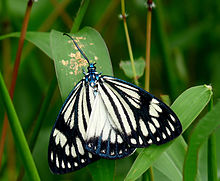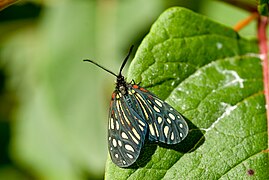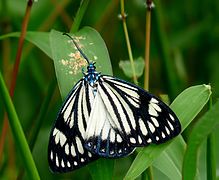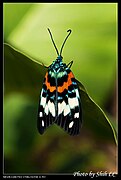
The Nymphalidae are the largest family of butterflies, with more than 6,000 species distributed throughout most of the world. Belonging to the superfamily Papilionoidea, they are usually medium-sized to large butterflies. Most species have a reduced pair of forelegs and many hold their colourful wings flat when resting. They are also called brush-footed butterflies or four-footed butterflies, because they are known to stand on only four legs while the other two are curled up; in some species, these forelegs have a brush-like set of hairs, which gives this family its other common name. Many species are brightly coloured and include popular species such as the emperors, monarch butterfly, admirals, tortoiseshells, and fritillaries. However, the under wings are, in contrast, often dull and in some species look remarkably like dead leaves, or are much paler, producing a cryptic effect that helps the butterflies blend into their surroundings.
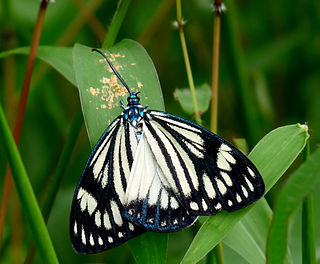
The Zygaenidae moths are a family of Lepidoptera. The majority of zygaenids are tropical, but they are nevertheless quite well represented in temperate regions. Some of the 1000 or so species are commonly known as burnet or forester moths, often qualified by the number of spots, although other families also have 'foresters'. They are also sometimes called smoky moths.

Saturniidae, members of which are commonly named the saturniids, is a family of Lepidoptera with an estimated 2,300 described species. The family contains some of the largest species of moths in the world. Notable members include the emperor moths, royal moths, and giant silk moths.

Riodinidae is the family of metalmark butterflies. The common name "metalmarks" refers to the small, metallic-looking spots commonly found on their wings. The 1,532 species are placed in 146 genera. Although mostly Neotropical in distribution, the family is also represented both in the Nearctic, Palearctic, Australasian (Dicallaneura), Afrotropic, and Indomalayan realms.

Nolidae is a family of moths with about 1,700 described species worldwide. They are mostly small with dull coloration, the main distinguishing feature being a silk cocoon with a vertical exit slit. The group is sometimes known as tuft moths, after the tufts of raised scales on the forewings of two subfamilies, Nolinae and Collomeninae. The larvae also tend to have muted colors and tufts of short hairs.

Neopseustidae is a small family of day and night-flying "archaic bell moths" in the order Lepidoptera. They are classified into their own superfamily Neopseustoidea and infraorder Neopseustina. Four genera are known. These primitive moths are restricted to South America and Southeast Asia. Their biology is unknown.

Mimallonidae (mimallonids), sometimes known as "sack-bearer" moths for the larval case-building behavior, are a family of Lepidoptera containing over 300 named species in 43 genera. These moths are found only in the New World, with most taxa occurring in the Neotropics. Adult moths are externally similar to those belonging to some of the other Macroheterocera families Bombycoidea and Drepanoidea, and thus have been variously treated as belonging to either one of these or other superfamilies.

Gelechioidea is the superfamily of moths that contains the case-bearers, twirler moths, and relatives, also simply called curved-horn moths or gelechioid moths. It is a large and poorly understood '"micromoth" superfamily, constituting one of the basal lineages of the Ditrysia.
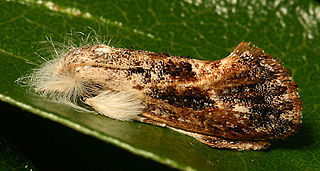
Acrolophinae is a family of moths in the order Lepidoptera. The subfamily comprises the burrowing webworm moths and tube moths and holds about 300 species in five genera, which occur in the wild only in the New World. It is closely related to the family Tineidae.

Epicopeiidae is a family of insects in the order Lepidoptera. They are known as oriental swallowtail moths as they closely resemble some oriental swallowtail butterflies. Epicopeiidae have highly varied structure in regards to body size and wing shape. Epicopeiidaen wing patterns are involved in complicated mimicry rings.

The Batrachedridae are a small family of tiny moths. These are small, slender moths which rest with their wings wrapped tightly around their bodies.
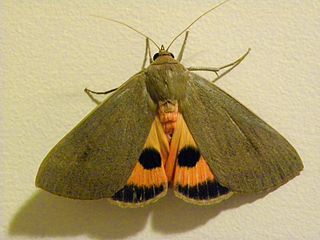
The Pyralini are a tribe of snout moths described by Pierre André Latreille in 1809. They belong to the subfamily Pyralinae, which contains the "typical" snout moths of the Old World and some other regions. The genus list presented here is provisional.

Hippeastreae is a tribe of plants belonging to the subfamily Amaryllidoideae of the Amaryllis family (Amaryllidaceae). Species in this tribe are distributed in South America. Flowers are large and showy, zygomorphic, with the stamens in varying lengths, inflorescence bracts are often fused basally. The seeds are flattened, winged or D-shaped. Reported basic chromosome numbers are x= 8-13, 17, and higher. All the species in this tribe present a remarkable aesthetic interest and horticultural value.

Gaeana is a genus of cicadas, most members of which have colourful marking on their forewings, found across tropical and temperate Asia. Their bright wing patterns have been hypothesized as being a case of Batesian mimicry where the toxic models may be day-flying moths of the subfamilies Zygaeninae and Arctiinae. It is closely related to the genus Tosena but is differentiated by the exposed tympanum and lacks spines on the sides of the pronotum.
Epimarptidae was a former, or is a possible, monotypic family of moths in the moth superfamily Gelechioidea. It can now be seen as either a synonym of family Batrachedridae, or a monotypic subfamily of that family.

Wurthiini is a tribe of the species-rich subfamily Spilomelinae in the pyraloid moth family Crambidae.
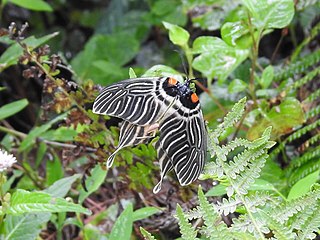
Elcysma ziroensis, the Apatani glory, is a moth of the family Zygaenidae. The species was first described by Punyo Chada, Monsoon Jyoti Gogoi and James John Young in 2017. It is endemic to the Arunachal Pradesh, India.

Mimaporia is a genus of moths in the Oriental swallowtail moth family Epicopeiidae consisting of two species, Mimaporia hmong and Mimaporia owadai. First described in 2017 by Shen-Horn Yen and Chia-Hsuan Wei, as the sole species Mimaporia hmong, from museum specimens held at the Natural History Museum, London. The second species, Mimaporia owadai was discovered two years after the initial description. Its members are found in Northern Vietnam, Northern India, and Sichuan Province in China.
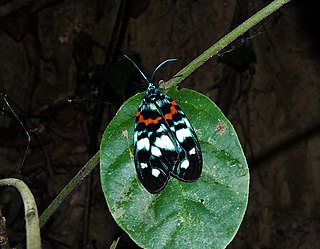
Erasmia pulchella is a species of moth in the burnet moth family Zygaenidae and in the subfamily Chalcosiinae. It was described by Frederick William Hope in 1840. It is found throughout Southeast Asia, with its range stretching from northern India, Myanmar, Laos, Thailand, Vietnam, China, Taiwan, and Japan. It is the type species of the genus Erasmia.

